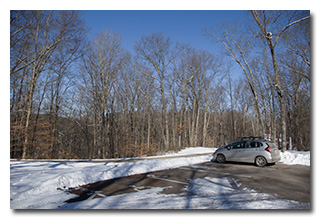
by William Eric McFadden
From the Lake Hope State Park website:
-
Lake Hope State Park offers a truly relaxing, yet rustic getaway from the high speed of modern life. The entire park lies within the Zaleski State Forest in the valley of Big Sandy Run. The park's heavily forested region is marked by steep gorges and narrow ridges with remnants of abandoned mining and iron-producing industries.
The park surrounds the lake and boasts a wooded family campground and a variety of cabins for families and gatherings of all sizes, including the roomy Laurel Lodge. No visit to the park is complete without a stop in the dining lodge for a hearty meal.
From the Zaleski State Forest website:
-
The 27,822-acre Zaleski State Forest is the second largest forest in Ohio's system of state forests.
Zaleski State Forest operates the only state-owned sawmill in Ohio. The mill produces rough sawn lumber for use by Ohio’s state forests and state parks as well as other government agencies.
Historic Moonville Tunnel is located within Zaleski State Forest on the Moonville Rail Trail right-of-way.
Pictures
Description
 On Saturday, January 29, 2022, one member of the Southeast Ohio Radio Adventure Team
performed a successful two-fer activation of Lake Hope State Park and Zaleski State Forest in Ohio as part of the Parks on the Air (POTA; link)
program.
On Saturday, January 29, 2022, one member of the Southeast Ohio Radio Adventure Team
performed a successful two-fer activation of Lake Hope State Park and Zaleski State Forest in Ohio as part of the Parks on the Air (POTA; link)
program.
Eric McFadden, WD8RIF, returned to Keeton Cemetery within Lake Hope State Park on a very cold (10°F) January morning to perform a two-fer activation of Lake Hope State Park and Zaleski State Forest. This was Eric's 19th activation of Lake Hope State Park (K-1968) and his 20th activation of Zaleski State Forest (K-5455), earning him the Oasis Repeat Offender Award for Zaleski State Forest.
Eric arrived at Keeton Cemetery at about 1450 UTC and quickly set up his 28½' wire vertical on his Jackite 31' telescoping fiberglass mast and drive-on mount, and set up his KX3 inside his car. Eric was on the air at 1457 UTC.
As at his previous visits to Keeton Cemetery, Eric found he had sufficiently-strong cell-signal to allow him to use the POTA Spots website (link) to spot himself and to look for possible park-to-park (P2P) QSOs.
Because his friend K8RAT suggested conditions on 20m might be good, Eric made the decision to try a 20m-only activation. He began his operation by checking POTA Spots for P2P opportunities and at 1500 UTC he made a P2P QSO on 20m with K4NYM who was activating Moody Branch Wildlife Area (K-6317) in Florida.
Finding a frequency to run on 20m, Eric's first QSO in this run came at 1506 UTC with WA5KMA in Texas. QSOs came steadily, with Eric's fifth QSO in this run coming at 1514 UTC with WD5GRW who was activating Hagerman National Wildlife Refuge (K-0548) in Texas. This run included a QSO with IK4IDF in Italy and QSOs with operators in Texas (2) and Colorodo.
Finally, Eric checked POTA Spots again for P2P QSO opportunities, and at 1537 UTC Eric made a P2P QSO on 20m with N5BO who was activating Lillian Swamp Complex Preserve State Conservation Area (K-3696) in Alabama.
In all, Eric made sixteen QSOs, with four P2P QSOs, in forty minutes, all on 20m, between the end of set-up and the start of tear-down. All of Eric's QSOs were CW and were made at the 5-watt level.
Eric also submitted his log to the World Wide Flora and Fauna in Amateur Radio (WWFF; link) program for Lake Hope State Park, KFF-1968.
(return)